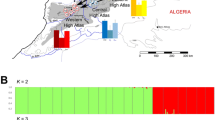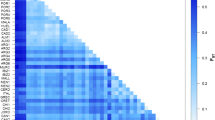Abstract
The level of polymorphism, genetic variability and relatedness of a population of Poa annua L. from South Shetlands Islands was studied and compared with results obtained for populations from two potential sources of introduction (Argentina—Ushuaia and Poland—Dziekanów Leśny) using the amplified fragment length polymorphism (AFLP) approach. Five primer pairs used for AFLP profiling amplified 226 scoreable DNA fragments that were used for Clustral and Factorial analyses. The level of molecular variability among all individuals from all the analysed populations reaches 30%. Clustral and Factorial analyses show that all populations formed clear-cut uniform groups according to their locations. However, population from King George Island show high variability. High genetic diversity may be related with escalated human activity at the area of Arctowski Station, favouring introductions of P. annua from many different sources and by many different vectors.

Similar content being viewed by others
References
Bergstrom DM, Convey P, Huiskes AHL (eds) (2006) Trends in Antarctic terrestrial and Limnetic ecosystems: Antarctica as a global indicator. Kluwer, Dordrecht
Block W, Convey P (2001) Seasonal and long-term variation in body water content of an Antarctic springtail—response to climate change? Polar Biol 24:764–770
Chwedorzewska KJ (2000) Studies on genetic changes in rye germplasm in relation to seed aging. PhD Thesis, Agriculture University in Warsaw, Poland
Chwedorzewska KJ (2006) Preliminary genetic study on species from genus Deschampsia from Antarctic (King George Is) and Arctic (Spitsbergen). Polar Biosci 19:142–147
Chwedorzewska KJ, Bednarek PT, Puchalski J, Krajewski P (2002) AFLP profiling of long-term stored and regenerated rye genebank samples. Cell Mol Biol Lett 7a:457–463
Chwedorzewska KJ, Bednarek PT, Puchalski J (2004) Molecular and morphological variation of Antarctic grass Deschampsia antarctica Desv. from King George Island (Antarctica). Acta Soc Bot Pol 73:23–29
Chwedorzewska KJ, Wojtuń B, Bednarek PT (2005) Genetical and Morphological variation of Saxifraga cespitosa L. from Spitsbergen (Svalbard)—a preliminary study. Polar Biol 28:802–804
Ciaputa P, Salwicka K (1997) Tourism at Antarctic “Arctowski” Station 1991–1997: policies for better management. Pol Polar Res 18:227–239
Convey P, Smith RIL (2006) Responses of terrestrial Antarctic ecosystems to climate change. Plant Ecol 18:1–10
Darmency H, Gasquez J (1981) Inheritance of triazine resistance in P. annua: consequences for population dynamics. New Phytol 89:487–493
Ellis WM (1973) The breeding system and variation in populations of Poa annua L. Evolution 27:656–662
Fenner M (1985) Seed ecology. Chapman and Hall, New York
Fowbert JA, Smith RIL (1994) Rapid population increase in native vascular plants in Argentine Islands, Antarctic Penisula. Arct Alp Res 26:290–296
Frenot Y, Gloaguen JC, Tréhen P (1997) Climate change in Kerguelen Islands and colonization of recently deglaciated area by Poa kerguelensis and Poa annua. In: Walton DWH (ed) Antarctic communities: species, structure and survival. Cambridge University Press, Cambridge, pp 358–366
Frenot Y, Aubry M, Misset MT, Gloaguen JC, Gourret JP, Lebouvier M (1999) Phenotypic plasticity and genetic diversity in Poa annua L. (Poaceae) at Crozet and Kerguelen Islands (subantartic). Polar Biol 22:302–310
Frenot Y, Gloaguen JC, Masse L, Lebouvier M (2001) Human activities, ecosystem disturbance and plant invasions in subantarctic Crozet, Karguelen and Amsterdam Islands. Biol Conserv 101:33–50
Frenot Y, Chown SL, Whinam J, Selkirk PM, Convey P, Skotnicki M, Bergstrom DM (2005a) Biological invasions in the Antarctic: extent, impacts and implications. Biol Rev 80:45–72
Frenot Y, Chown SL, Whinam J, Selkirk PM, Convey P, Skotnicki M, Bergstrom DM (2005b) Biological invasion in the Antarctic: extent, impacts and implications. Biol Rev 80:45–72
Hattersly-Smith G (1951) King George Island. Alpine J 282:67–75
Headland RK (1989) Chronology list of Antarctic expeditions and related historical events. Cambridge University Press, Cambridge
Heide OM (2001) Flowering responses of contrasting ecotypes of Poa annua and their putative ancestors Poa infirma and Poa supina. Ann Bot 87:795–804
Hennion F, Huiskes AHL, Robinson S, Convey P (2006) Trends in Antarctic and Limnetic ecosystems: Antarctic as global indicator. In: Bergstrom DM, Convey P, Huiskes AHL (eds). Springer, Heidelberg, pp 129–155
Johnson PG, Rummele BA, Velguth P, White DB Ascher PD (1993) An overview of Poa annua L. reproductive biology. Int Tufgrass Soc Res J 7:789–804
Kejna M (1999) Air temperature on King George Island, South Shetland Islands, Antarctica. Pol Polar Res 20:183–201
Koshy TK (1969) Breeding systems in annua bluegrass, Poa annua L. Crop Sci 9:10–43
McIntosh WA, Walton DWH (2000) Environmental Management Plan for South Georgia. Government of South Georgia and South Sandwich Islands, 105 pp
Mengistu LW, Mueller-Warrant GW, Barker RE (2000) Genetic diversity of Poa annua in western Oregon grass seed crop. Theor Appl Genet 101:70–79
Olech M (1996) Human impact on terrestrial ecosystems in west Antarctica. Proc NIPR Symp Polar Biol 9:299–306
Olech M (2003) Expansion of alien vascular plant Poa annua L. in the vicinity of the Henryk Arctowski Station—a consequence of climate change? In: Olech M (ed) The functioning of polar ecosystems as viewed against global environmental changes. XXIX International Polar Symposium, pp 89–90
Peakall R, Smouse PE (2001) GenALEx V5: genetic analysis in Excel. Population genetic software for teaching and research. Australian National University, Canberra. http://www.anu.edu.au/BoZo/GenALEx/
Rakusa -Suszczewski S (1998) The past and present of King George Island (South Shetland Islands, Antarctica) 19:249–252
Slabber S, Chown SL (2002) The first record of a terrestrial crustacean, Porcellio scaber (Isopoda, Porcellionidae), from sub-Antarctic Marion Island. Polar Biol 25:855–858
Smith RIL (1994) Vascular plants as indicators of regional warming in Antarctica. Oecologia 99:322–328
Smith RIL (2001) Plant colonization response to climate change in the Antarctic. Folia Fac. Sci. Nat. Univ. Masarykianae brunensis. Geograph 25:19–33
Smith RIL (2003) The enigma of Colobanthus quitensis and Deschampsia antarctica in Antarctica. In: Huiskes AHL, Gieskes WWC, Rozema J, Schorno RML, van der Vies SM, Wolff WJ (eds) Antarctic biology in global context. Backhuys, Leiden, pp 234–239
Stonehouse B (1992) Monitoring shipborne visitors to Antarctica: a preliminary field study. Polar Rec 28:213–218
Tutin TG (1957) A contribution to the experimental taxonomy of Poa annua L. Warsonia 4:1–10
Warwick SI (1979) The biology of Canadians 37. Poa annua L. Can J Plant Sci 59:1053–1066
Wasley J (2004) The effect of climate change on Antarctic terrestrial flora. PhD Thesis. University of Wollongong, pp 1–200
Whinam J, Chilcott N, Bergstrom DM (2005) Sub-antarctic hitchhikers: expeditioners as vectors for the introduction of alien organisms. Biol Conserv 121:207–219
Vos P, Hogers R, Bleeke M, van de Lee T, Hornes M, Frijters A, Pot J, Peleman J, Kuiper M, Zauber M (1995) AFLP: a new technique for DNA fingerprinting. Nucl Acids Res 23:4407–4414
Acknowledgments
The author would like to thank Professor Maria Olech from the Institute of Botany, Jagiellonian University for providing assistance with the field and research work. I also would like to thank Professor Stanisław Rakusa-Suszczewski for establishing such a great Station.
Author information
Authors and Affiliations
Corresponding author
Rights and permissions
About this article
Cite this article
Chwedorzewska, K.J. Poa annua L. in Antarctic: searching for the source of introduction. Polar Biol 31, 263–268 (2008). https://doi.org/10.1007/s00300-007-0353-4
Received:
Revised:
Accepted:
Published:
Issue Date:
DOI: https://doi.org/10.1007/s00300-007-0353-4




